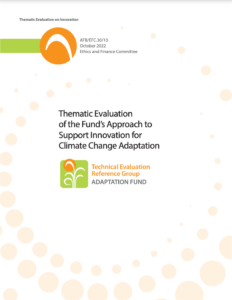Evaluating and Enhancing Innovation in the Adaptation Fund’s Portfolio
Variously defined (or undefined), innovation, in the climate adaptation space at least, has been widely accepted as a process vital for scaling up and accelerating global adaptation action. Despite this, the challenges associated with defining and identifying ‘innovative’ adaptation approaches greatly affect the mobilisation of climate finance towards innovative adaptation.

Central to providing and distributing global adaptation finance is the Adaptation Fund. It was established through decisions by the Parties to the UNFCCC to finance concrete adaptation projects and programmes in developing countries that are particularly vulnerable to the adverse effects of climate change. The Fund supports country-driven projects and programmes, innovation, and global learning for effective adaptation.
The Fund’s activities are designed to build national and local adaptive capacities while reaching and engaging the most vulnerable groups and integrating gender consideration to provide equal opportunity to access and benefit from the Fund’s resources. They also aim to enhance synergies with other sources of climate finance while creating models that can be replicated or scaled up. It is in this context that innovation has become one of the Fund’s three strategic pillars in recent years.
Collaborating with the Adaptation Fund Technical Evaluation Reference Group (AF-TERG)
Comprised of independent evaluation experts, the AF-TERG is an independent evaluation advisory group established in 2018 to ensure the implementation of the Adaptation Fund’s evaluation framework.
Since December 2021, PlanAdapt has been collaborating with AF-TERG on an exciting piece of work supporting the thematic evaluation of innovation in the Adaptation Fund and its portfolio. The work aims to inform the ongoing discussions around innovation at the AF and across the wider climate adaptation community.
Beginning with a landscape analysis, PlanAdapt will explore the past and current experiences of the Fund and others working in the space of innovation and climate adaptation. After this, there will be a period of consultations with relevant individuals and organisations working on innovation, both within the AF as well as engaging with external actors. PlanAdapt will support the analysis of the AF’s operations and portfolio by deep-diving into case studies to better understand innovation in the Fund. Finally, this work will be synthesized into a report.
So far, our scoping of the innovation landscape has shown that the concept of innovation has broad appeal and longevity in many different spaces, including the climate adaptation space. Innovation is not only confined to the private sector: there are many examples of organisations such as multilateral climate funds, non-governmental organisations, UN agencies, foundations, and research institutions, as well as banks, who have integrated innovation into their strategies and activities.
Recently published documents such as the GEF’s Program Evaluation of the Special Climate Change Fund (SCCF) and this working paper by the GCF on Accelerating and Scaling up Climate Innovation, have shed light on how key organisations within the adaptation space are embedding innovation into their work, and how successful (or not) this has been. Equally, some papers seem to have withstood the test of time, like IFAD’s Innovation Strategy published in 2007, symbolic of the history (and persistence) of innovation within organisations working on climate change and development. Our work so far has demonstrated the importance of continuing to disentangle innovation within the climate adaptation space; to enable the future of innovation in climate adaptation finance to be better envisioned.
 To what extent does successful adaptation to climate impacts depend on the ability and capacity to innovate? More work must be done to better understand how innovation processes are enabled; how they can be monitored and supported by financial and non-financial means. Assessing innovation in the wider adaptation landscape offers insights into how innovative adaptation is currently understood, providing an evidence base and guidance to inform the financing of adaptation in the future.
To what extent does successful adaptation to climate impacts depend on the ability and capacity to innovate? More work must be done to better understand how innovation processes are enabled; how they can be monitored and supported by financial and non-financial means. Assessing innovation in the wider adaptation landscape offers insights into how innovative adaptation is currently understood, providing an evidence base and guidance to inform the financing of adaptation in the future.
The collaboration with the AF-TERG and other stakeholders of the Adaptation Fund (AF), such as the Secretariat and the Task Force on Innovation, has culminated in a report that summarizes and assesses the AF’s work and support for innovation (see also the related official AF Board document) to enable successful and effective climate adaptation. The findings and the recommendations will help to shape the future of innovation in adaptation finance, which will influence the types of adaptation funded going forward. We are excited to have shared this journey with the AF-TERG to expand and enhance the understanding of innovation in adaptation.
See also our blog series ‘Where Social Innovation, Social Entrepreneurship and Climate Change Adaptation Meet‘
